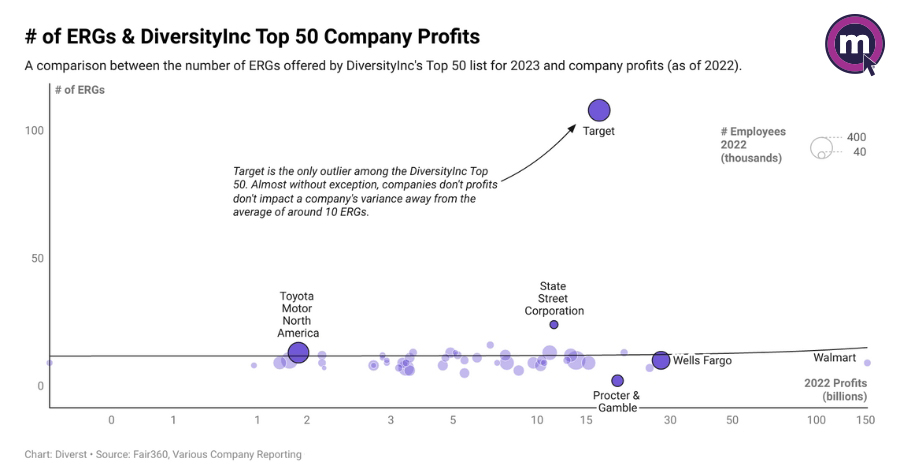There are a multitude of factors that can make budgeting (and budgeting conversations) difficult. Yet, over time, I’ve found that there are two big areas where the ERG budget discussions tend to get hung up:
- How much to properly budget to guarantee the ERG’s goals are met
- Where that money should be allocated
If you’re here, you’re likely working your way through an ERG budget for the first time. If so, getting that budget right will go a long way toward getting executive leaders to approve the budget you want or need for your group. We’ll walk you through the process in 5 ways:
- Help you understand what an ERG budget is and why you need one
- How much you may be able to obtain for your budget (based on survey data)
- What line items should be included in your budget
- What line items you should exclude from your budget
- A budget exercise and calculator you can use to estimate your needs
Note: This is a very manual approach to ERG budgeting that can work if your ERG landscape is small. If you’re managing ERGs at scale, hop on a call with us to learn how CommunityCliQ employee community software simplifies budgeting for enterprises.
If you’re building an ERG program from scratch, check out our detailed guide, How to Start an ERG Program in 6 Steps.
What Is An ERG Budget?
An ERG budget is a financial plan designed specifically for Employee Resource Groups. As with any other program-focused budget, an ERG budget describes where funds should be allocated for the program to support the various activities and needs the group plans to undertake. ERG budgets provide not just the money needed to ensure the program works as intended but also help the organization achieve its DEI goals.
What Items Should I Include in an ERG Budget?

The items you include in your ERG budget should not only align with the primary goals of an ERG but should also include activities with measurable outcomes. At a high level, your ERG budget will include community/culture building, networking, and development opportunities (both personal and professional).
If you’re unfamiliar with what metrics matter for an ERG, check out our post on ERG metrics and KPIs.
Taking those needs into account, we recommend the following items be included in your ERG budget:
1. Event logistics and cultural programming
This line item will include needs such as renting locations, chairs, catering, and more. If your company has office space, you can likely eliminate the most significant cost associated with this part (renting space and equipment). The other needs, like catering costs, will need to be included in your estimate.
2. Community initiatives
If your ERG is responsible for the success of any corporate responsibility initiatives, the cost of running those initiatives should be included in the budget. This may include the cost of event sponsorship, charity matching, fundraising, and volunteering.
3. External support (consultants, guest speakers, group workshops)
This is often one of the biggest expenses within your ERG budget. Consider these the “big ticket” items. Consequently, they’re often the type of activities that help build your ERG membership.
4. Personal and professional development
A key reason why employees join ERGs is to learn, grow, and navigate their roles. For many employees, this happens best when that development can occur within the framework of an ERG and from individuals who have shared some of the same struggles they face within the workplace. Your ERG budget should account for the cost of development through different avenues, including attending conferences, ICF-certified coaching, leadership development programs, and mentorship.
What Should I Exclude from my ERG Budget?
A common misconception with ERGs is that anything related to the ERG should be in the budget. That’s not the case. Trying to include everything under the sun as part of your ERG budget is likely to get your budget request rejected. Budgets are negotiations. Your best chance to get as budget as you want or need is to come into the budget discussion with reasonable requests.
Note that “reasonable” doesn’t mean “small.” Think big with your budget. Definitely ask for as much as you believe you need to achieve the best outcomes for your ERG. But don’t include the following items in your budget.
1. ERG lead compensation
I understand why you want to include this in your budget. It’s only fair that ERG leads get compensated for the extra time and skillset usage it requires to lead an ERG. And unfortunately, far too many companies fail to compensate their ERG leaders.
In its survey, The Rise Journey found that 64% of companies do not compensate their ERG leads at all. While more companies are starting to provide some financial incentives for ERG leaders, the reality is that most still don’t. And those that do typically offer incentives between $1 and $1,000. Companies like LinkedIn, which started paying ERG chairs $10,000 for the role in 2021, are an aberration.
So, where should that ERG leader compensation come from? Your HR or functional department budgets. Companies shouldn’t make people choose between being fairly compensated for emotional/actual labor or adequately serving their employee population (and meeting their strategic DEI goals), but reality is a bit different from desire here.
ERG leadership means stepping into an HR and talent development role. The budget should come from there, as well.
2. Branding and recruitment
This is another area that should fall under the HR budget. Boosting ERG membership and using ERGs as a recruitment tool is an HR goal, first and foremost. HR, talent, and recruiting should own and fund DEI-focused candidate sourcing, DEI-focused brand/job advertising campaigns, as well as production costs for external facing multimedia content related to showcasing the work of ERGs.
Functional department heads who benefit from these campaigns can also contribute to sourcing and advertising budgets, while IT and marketing teams can contribute to content production costs.
How Much Money Should I Request for my ERG Budget
This is possibly the most difficult part of creating an ERG budget. Chances are high that you want more money in your budget than your organization will allow. That’s perfectly fine! As we noted earlier, setting budgets typically involves a negotiation between ERG leaders or executive sponsors of that ERG and those within the organization who approve budgets, be it the executive team, finance team, or the board of directors.
There are two big questions you need to ask about your budget size:
- How much can your organization afford to spend?
- How effectively can you connect your requested budget to measurable outcomes?
Obviously, if your company generates $1 million in profit, you’re probably not getting a $50,000 ERG budget. Still, what you ask for in your budget can be guided by and supported by existing data.
How much should I ask for in the budget?
Let’s talk about the “how much” question. In its 2022 State of the ERG report, The Rise Journey found that:
- 21% had no budget at all for their ERGs (yikes!)
- 10% had an annual budget between $1 and $1,500
- 21% had an annual budget between $1,500 and $5,000
- 17% had an annual budget between $5,001 and $10,000
- 14% had an annual budget between $10,000 and $50,000
- 2% had an annual budget of more than $50,000
- The remaining companies surveyed had no information to provide on their ERG budgets
Notably, The Rise Journey’s data over time shows that ERG budgets are shrinking, but more positively, more companies are offering budgets. Overall, the average ERG budget falls between $1,500 and $10,000.
Is that influenced by company size? Surprisingly, not really. The biggest factor influencing an ERG budget is the total number of ERGs that your organization has.
In previous research, we found that companies have an average of 10 ERGs. In The Rise Journey’s study, companies with 0-5 ERGs are most likely to have no budget at all, while those with 6-10 ERGs tend to have budgets between $5,000 and $10,000.

Overall, budgets typically result in a spend that’s around $2 to $5 per employee. Taken together, this should inform you in how you create your budget.
2 Steps to Create Your ERG Budget
Let’s pull all of this information together so you can create your ERG budget in three steps.
- Determine your total likely budget
- Allocate that total budget to your different line items
This may seem like you’re working backward. After all, it would seem to make sense to determine how much you want to spend on the line items and then add that together into a total cost. Yet remember that you’re going to a data-based approach to what your company will likely spend. That means you need to start with the amount you’re likely to get first and then figure out how much you can allocate to each of the line items.
First, use our free ERG Budget Calculator
All you need to provide in this calculator are three fields:
- Your previous years’ ERG budget
- The number of members in your ERG
- Your number of planned ERG activities for the yea
The calculator will do the rest. We designed it to take into consideration all of the budget elements we discussed in this post (the average amount companies spend per employee and average costs for ERG activities that appear on your budget).
ERG Budget Estimator
Here’s an example of an outcome from this calculator:
- Previous budget: $0
- Number of ERG members: 25
- Number of planned events: 5
Estimated budget: $2,250
The results of the calculator are only a baseline. You’ll likely adjust the needs up or down, depending on what makes sense for your unique situation.
Next, allocate that money across your line items
Once you have an estimated budget, split those costs across your key budget line items. For example, our sample ERG results in an estimated budget of $2,250. That budget allocation breaks down the following way across the different line items:
- Event Logistics & Cultural Programming: Allocating around $900, this portion of the budget focuses on venue rentals or digital platforms, ensuring each gathering is well-organized and accessible.
- External Support: Approximately $750 is dedicated to guest speakers and workshops. This ensures access to quality speakers and meaningful workshops without excessive costs.
- Community Initiatives: With $125 allocated, the ERG is able to engage in community activities, such as volunteering and sponsorships, fostering a sense of social responsibility.
- Professional Development: The remaining $475 is earmarked for professional development, such as attending relevant conferences or training programs and contributing to the growth and advancement of ERG members.
This budget serves as a foundational step, balancing essential activities with the need for strategic financial management. This is also just a framework. For example, if you believe that you’ll need more money for professional development ($475 isn’t going to pay for 25 ERG members to attend a conference, for example), be sure to up that ask for more.
This exercise will help you get a basic idea and help you launch your budget request from there with the proper adjustments. Build your budget based on what your ERG members value and need most out of the experience.
ERG Budgeting Doesn’t End with the Budget
Creating a budget for your ERG will take some time and patience as you research and plan out what you plan to do for the year. Once you have your budget in place, make sure you’ve aligned your line items with the type of outcomes your company wants to see that are commonly associated with talent development.
All of this assumes something very important: You have a way to track spending. Budget tracking can be complicated, especially when you have a million other things to do. Simplifying that process with ERG management software is a boon, especially when that software simplifies a handful of other management needs.
Get your budget in order. Then, give us a call and see how CommunityCliQ employee community software makes managing your groups a breeze!




